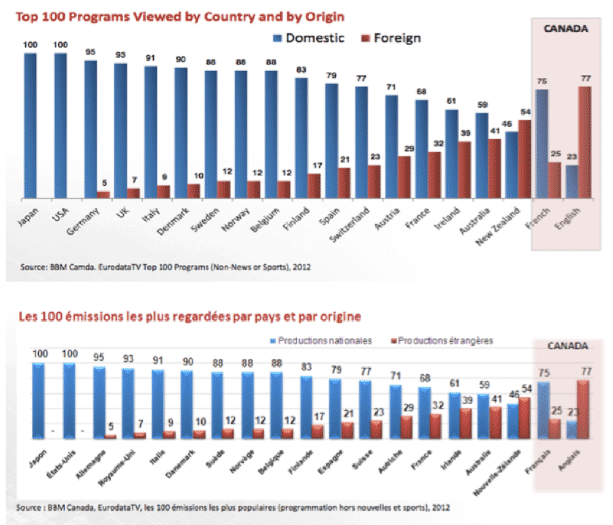The Media and Local Communities - Supplementary Submission
Written response to a question coming out of FRIENDS' presentation to the House of Commons Standing Committee on Canadian Heritage on the future of local TV in Canada.
Mr. Jean-François Lafleur
Clerk
Standing Committee on Canadian Heritage
House of Commons
131 Queen Street, 6th Floor
Ottawa, ON
K1A 0A6
Dear Mr. Lafleur:
During FRIENDS’ appearance before your Committee on April 12, we undertook to respond to a question posed by Mr. Maguire in writing, as there was no time available for an oral response on that occasion.
Mr. Maguire asked: “Some of the local television news is in pretty good shape south of the border, and I’m just wondering if there’s anything we can learn from the Americans to strengthen local TV news that we have here?”
FRIENDS’ response:
Support Measures for Local TV in the United States
Over the last seven decades, the U.S. has adopted a robust set of mechanisms that support local TV broadcasters. The extent of support far exceeds anything adopted by Canada. These measures include:
Protection of program rights purchased by local broadcasters
Both cable and satellite companies are required to “black out” programming imported into local markets that has been purchased by the local broadcaster. In Canada, simultaneous substitution or “simulcast” offers only limited protection against identical programming imported into a local market at the same time.
“Distant signals” forbidden
DTH satellite companies in the U.S. are all but forbidden to import distant signals due to the negative impact on local broadcasters.1 In Canada, DTH and cable providers are free, for example, to beam Vancouver TV station signals into the homes of Toronto viewers, thereby fragmenting the available audience for local broadcasters even further, and without compensation.
Paying for local signals
“Retransmission consent” allows local TV stations in the U.S. to negotiate compensation for their carriage by cable operators. Over two decades, this has evolved into cash payments to local broadcasters estimated currently at $2.5 billion per annum.2 In Canada, a variation on this approach was proposed by the CRTC in 2010, but found to be ultra vires by the Federal Court of Appeal,3 which suggests that a Broadcasting Act amendment would be required for implementation.
Compensation for expropriation
Local broadcasters in the U.S. are to be reimbursed from a $1.75 billion fund established by Congress for the cost of relocating their signals4 when 600 MHz broadcast spectrum is repurposed for mobile services starting in 2017.5 In Canada, no compensation has thus far been offered to local TV broadcasters, who face similar, if not greater incremental costs than their American counterparts.
U.S. local TV also benefits from a much higher share of total TV advertising (43% of the TV ad ‘pie’ vs. 20% in Canada). U.S. local TV stations have continued to grow advertising revenues – from $15.8 billion in 2009 to $20.8 billion in 2014 – and are forecast to continue to grow advertising revenues through to 2019 (to $23.2 billion).6
Because of this much more supportive public policy framework, U.S. local TV stations are in far better financial health, and better equipped than their Canadian counterparts to compete with new Internet-based media.
• • •
National Content – International Comparisons
We also wish to provide further information in response to a question from Mr. O’Regan: *“**Let me ask you and give you an opportunity maybe to address best practices. When you talk about Canadian content and the promotion or protection of Canadian content what are some of the better practices that you've seen in comparable economies, obviously outside of the United States, but I'm thinking more of European countries and Australia in terms of the amount of national content and how they go about their cultural industries through demanding carriers, whether they be foreign carriers that broadcast within or domestic carriers, what percentages do they ask be of local content or national content, but domestic content?*
There was insufficient time available to respond fully to his question last week. We would like to share with the Committee a graphic originally produced by CBC/SRC two years ago, based on 2012 data. It is possible that CBC/SRC has more up-to-date information but, in our view, these data respond in broad terms to Mr. O’Regan’s question:

If we can be helpful to the Committee in other ways during your media and local communities study, please do not hesitate to contact us.
Yours sincerely,

Ian Morrison
Spokesperson
1 See, For example, http://www.fcc.gov/guides/television-broadcast-stations-satellite
2 Industry estimate.
3 Reference Re Broadcasting Act, 2011 FCA 64, [2012] 4 F.C.R. 231. http://reports.fja-cmf.gc.ca/eng/2012/2011fca64.html
4 Authorized under the 2012 Spectrum Act
5 See Decision on Repurposing the 600 MHz Band, August 2015, http://www.ic.gc.ca/eic/site/smt-gst.nsf/eng/sf11049.html
The U.S. also implemented an incentive auction, designed to facilitate the repurposing of spectrum by encouraging OTA TV broadcasters to voluntarily relinquish some or all of their spectrum usage rights in exchange for proceeds from an auction of new mobile licences. Broadcast Incentive Auction 101, Federal Communications Commission,
http://wireless.fcc.gov/incentiveauctions/learn-program/Broadcast_Incentive_Auction_101_slides.pd
6 Source: BIA/Kelsey Consulting
Apr 12, 2016 — Policy Brief: The Media and Local Communities FRIENDS presentation to the House of Commons Standing Committee on Canadian Heritage on the future of local TV in Canada.
